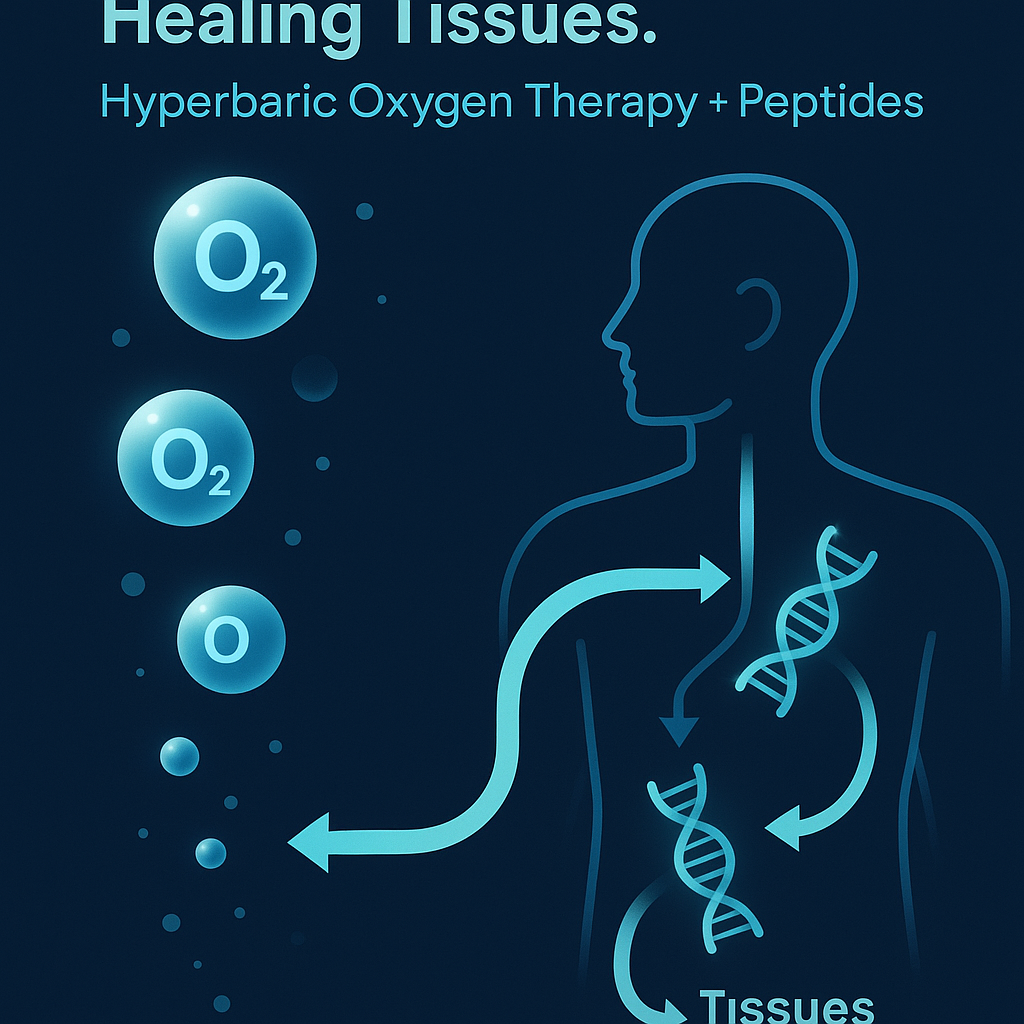The Mechanism of Action
Hyperbaric oxygen therapy (HBOT) exploits increased barometric pressure to enhance oxygen delivery in the body, elevating dissolved O₂ levels significantly. Under hyperbaric conditions, arterial pO₂ can exceed 1,500 mm Hg, which is unattainable during normal atmospheric pressure. This oxygen supersaturation activates various regenerative pathways that are crucial for tissue engineering and cellular therapies. For instance, HBOT promotes oxygen-dependent matrix synthesis and angiogenesis by enhancing the maturation of collagen, thereby accelerating wound healing processes. The enzyme prolyl-4-hydroxylase, vital for collagen synthesis, requires oxygen for its activity. By improving the availability of O₂, HBOT accelerates extracellular matrix deposition and promotes angiogenesis through the upregulation of growth factors such as vascular endothelial growth factor (VEGF) [Source: Thackham & McElwain].
Peptides and Their Role
Peptides play an importantly synergistic role in the effects of HBOT. Research demonstrates that neuropeptides, such as the calcitonin gene-related peptide (CGRP), can significantly enhance the physiological benefits of HBOT. For example, studies show that administering ultra-early HBOT after spinal cord injury increases CGRP levels, which aids in normalizing bone metabolism and preventing disuse osteoporosis [Source: Liu et al.]. Likewise, endogenous opioid peptides are released in response to nitric oxide generated during HBOT, providing analgesic effects and reducing neuroinflammation [Source: Schiavo et al.].
Clinical Studies
Clinical evidence emphasizing the effectiveness of HBOT paired with peptide interventions is growing. A meta-analysis of chronic wound management demonstrated that adjunctive HBOT significantly shortened the epithelialization time in patients treated with topical collagen peptides [Source: Thackham & McElwain]. Furthermore, studies exploring its application in orthopedic regeneration showed that early application of HBOT raised CGRP levels, thereby enhancing bone mineral density and promoting recovery [Source: Liu et al.]. Additional clinical trials involving patients with vascular dementia reveal that HBOT led to elevated Humanin levels and significant improvements in cognitive scores, indicating its neuroprotective effects [Source: Xu et al.].
Future Directions in Research
To utilize the full therapeutic potential of the HBOT-peptide interaction, future research must address several critical areas. Understanding the kinetics of pressure-dose peptide responses is essential, as current data on peptide elevation following HBOT is limited. Future studies should evaluate graded pressures and their subsequent effects on the timing and magnitude of peptide responses [Source: Liu et al.].
Moreover, employing multi-omics approaches to map the hyperoxic peptidome could unveil novel peptides and signaling pathways activated by HBOT, enhancing our understanding of its mechanisms [Source: Ortega et al.]. Larger-scale randomized controlled trials are urgently needed to evaluate hard clinical endpoints, such as infection-free survival and time to full epithelialization, to solidify the clinical applications of HBOT in conjunction with peptide-based therapies.
Conclusion
Current evidence positions peptides as key enhancers of hyperbaric oxygen therapy. The integration of HBOT and peptides demonstrates a multifaceted approach to accelerate tissue regeneration via improved collagen synthesis, enhanced antimicrobial functionality, and neuroprotection. With continuing advancements in research, specifically in understanding how these interventions interplay, the future of regenerative medicine could significantly benefit from finely tuned HBOT protocols that leverage peptide biology to enhance therapeutic outcomes across diverse clinical scenarios [Source: Lindenmann et al.].
Sources
- Liu et al. – Effects of ultra-early hyperbaric oxygen therapy on femoral calcitonin gene-related peptide and bone metabolism of rats with complete spinal transection
- Thackham & McElwain – The use of hyperbaric oxygen therapy to treat chronic wounds: a review
- Schiavo et al. – Mechanistic rationale and clinical efficacy of hyperbaric oxygen therapy in chronic neuropathic pain: an evidence‐based narrative review
- Xu et al. – Protective effect of hyperbaric oxygen therapy on cognitive function in patients with vascular dementia
- Ortega et al. – A general overview on the hyperbaric oxygen therapy: applications, mechanisms and translational opportunities
- Lindenmann et al. – Hyperbaric oxygen therapy and tissue regeneration: a literature survey
- Memar et al. – Hyperbaric oxygen therapy: Antimicrobial mechanisms and clinical application for infections
- Silva et al. – Responses of matrix metalloproteinases to hyperbaric oxygen treatment: changing for good or ill?
